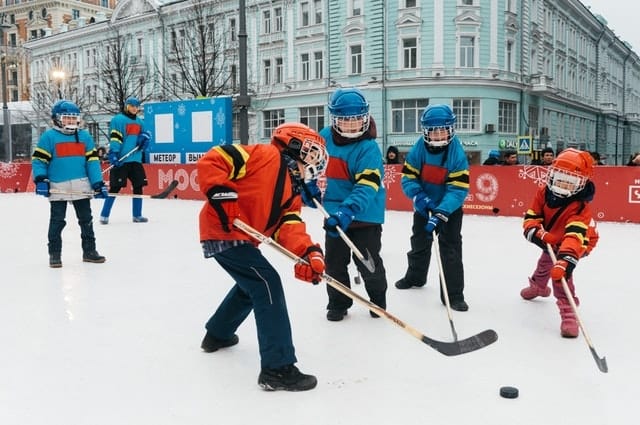In this article, For Kids+ has listed various different types of sports for kids. The list is broken into individual sports and team sports, ordered alphabetically from A – Z. Following that is a list of gymnastic sports and martial arts. Rounding off the list are the various Olympic sports (both summer and winter games). Continue reading to the end for a section on the top 10 most popular sports around the world plus some important benefits of sports, in general, for your children.
List of sports A – Z
1. Individual sports
- Alpine skiing
- Archery
- Billiards
- Bocce ball
- Bodysurfing
- Bowling
- Canoeing
- Cross-country skiing
- Cycling
- Dog sledding
- Diving
- Fishing
- Fly-fishing
- Golf
- Hacky sack
- Hang gliding
- Mountaineering
- Horse Riding
- Ice skating
- Japanese sword arts
- Kayaking
- Kickboxing
- Motocross racing
- Mountain biking
- Parachuting
- Parasailing
- Pilates
- Qi gong
- Rafting
- Rock climbing
- Rollerblading
- Rope climbing
- Rope jumping
- Rowing
- Sailing
- Scuba diving
- Shuffleboard
- Skimboarding
- Skydiving
- Sky surfing
- Sledding
- Snorkeling
- Snowboarding
- Snowmobile racing
- Snowshoeing
- Snow skiing
- Speed skating
- Surfing
- Swimming
- Tai chi
- Trapeze artistry
- Triathlon training
- Unicycling
- Wakeboarding
- Waterskiing
- Weight lifting
- Windsurfing
- Yoga
2. Team Sports

- Badminton
- Basketball
- Baseball
- Boxing
- Broomball
- Cheerleading
- Cricket
- Croquet
- Curling
- Fencing
- Field hockey
- Flag football
- Football
- Handball
- Hockey
- Hurling
- Jai alai
- Lacrosse
- Laser tag
- Lawn bowling
- Paintball
- Racquetball
- Rugby
- Soccer
- Softball
- Squash
- Synchronized swimming
- Table tennis
- Tennis
- Ultimate Frisbee
- Volleyball
- Wrestling
3. Gymnastic Games
- Acrobatic Gymnastics
- Balance beam
- Floor exercises
- High bar
- Parallel bars
- Pommel horse
- Rhythmic
- Still rings
- Trampoline
- Tumbling
- Uneven parallel bars
- Vault
Read more about the different types of gymnastics.
4. Martial Arts
a. Japanese Martial Arts
- Aikido
- Judo
- Jujutsu (jiu-jitsu)
- Karate
- Kendo
b. Indian Martial Arts
- Dravidian
- Gatka
- Kalaripayattu
- Kuttu varisai
- Varma kalai
c. Brazilian Martial Arts
- Capoeira
- Brazilian jiu-jitsu
d. Korean Martial Arts
- Hapkido
- Taekwondo
e. Chinese Martial Arts
- Bagua
- Drunken Boxing
- Eagle Claw
- Five Animals
- Hsing I
- Kung fu
- Lau Gar
- Monkey
- Praying Mantis
- Tai chi chuan
- White Crane
- Wing chun
List of Summer and Winter Olympic Sports
Here’s a list of sports that are part of the Olympic Games. Some of these sports are a part of the summer competition program, and others are played in the Winter Olympic Games.
Summer Olympic sports
- Archery
- Artistic swimming
- Athletics
- Badminton
- Basketball
- Beach volleyball
- Boxing
- Canoe slalom
- Canoe sprint
- Cycling: BMX)
- Cycling: Mountain Bike)
- Cycling: Road
- Cycling: Track
- Diving
- Equestrian: Dressage
- Equestrian: Eventing
- Equestrian: Jumping
- Fencing
- Football
- Golf
- Gymnastics: Artistic
- Gymnastics: Rhythmic
- Handball
- Hockey
- Judo
- Marathon Swimming
- Modern Pentathlon
- Rowing
- Rugby
- Sailing
- Shooting
- Swimming
- Table tennis
- Taekwondo
- Tennis
- Trampoline
- Triathlon
- Volleyball
- Water polo
- Weightlifting
- Wrestling: Freestyle
- Wrestling: Greco-Roman
Winter Sports
- Alpine Skiing
- Biathlon
- Bobsleigh
- Cross-country skiing
- Curling
- Figure skating
- Freestyle skiing
- Ice hockey
- Luge
- Nordic Combined
- Short track
- Skeleton
- Ski jumping
- Snowboarding
- Speed skating
The most popular sports in the world
Here are the most popular sports in the world nowadays, according to WorldAtlas.com.
| Rank | Sport | Estimated Followers | Area of population |
| 1 | Association Football (Soccer) | 4.0 billion | Global |
| 2 | Cricket | 2.5 billion | UK and Commonwealth |
| 3 | Field Hockey | 2 billion | Europe, Africa, Asia and Australia |
| 4 | Tennis | 1 billion | Global |
| 5 | Volleyball | 900 million | Western Europe and North America |
| 6 | Table Tennis | 875 million | Global |
| 7 | Basketball | 825 million | Global |
| 8 | Baseball | 500 million | United States, Caribbean and Japan |
| 9 | Rugby | 475 million | UK and Commonwealth |
| 10 | Golf | 450 million | Western Europe, North America and East Asia |
General benefits of sports for kids
1. Games Teach Socialization
Teaching children how to develop relationships may not be something you’d normally think about when playing games, but games provide a great opportunity for kids to develop social skills such as sharing, showing respect, supporting teammates, controlling their emotions and more.
Playing a game can teach you all that and have practical applications as well, such as when you use a name game to introduce one child to another.
Game time is also an excellent time to reinforce a child’s listening skills.
For instance, when one child has a question about a game, be sure that all of the children listen to the explanation.
When playing games with kids, always remember to de-emphasize winning and competition and emphasize good sportsmanship.
2. Sports Provide Opportunities to Learn Self-Control
Children, at a young age, have a difficult time controlling their feelings and emotions.
Daily practice of a sport or game can help them learn this life skill, as it’ll teach them discipline.
Find the right moments to discuss handling frustration with your children.
For example, if a child loses his temper during a game, that’s the perfect moment for a conversation about this subject.
3. Promote Healthy Competition, Collaboration and Achieving Goals
Sports can be a great motivator to help children learn to achieve goals. Since there are both team sports and individual sports, the opportunities for children to achieve goals can come from collaboration and competition.
It is best to focus on the effort they put into their activity and how they can beat their personal best (eg. score, time, etc.). In team sports there are plenty of opportunities to improve one’s collaboration (eg passing the ball).
Another motivator sport naturally offers is competition. Young athletes can strive towards winning and when losing they can learn that that’s a natural part of sports as well. Prizes and awards like custom race medals can be handed out to make things even more interesting.
4. Learning the Rules of a New Game Can Teach Focus
Teaching your child how to play a new game can be challenging. Most kids have an attention span of about fifteen minutes, so as adults, we must be creative.
First, connect before you direct: Ask all of the kids in front of you to look you in your eyes first, and then begin talking to them.
Next, as you explain the game, stay brief, stay simple and ask the kids to repeat your requests back to you. Ask questions to be sure they were listening.
The games that work best for this age group are those that have just a few, simple rules, and preferably, require the children to complete only one task at a time.
Since adventure is everything for this age group, learning a new sport or skill can be an easy sell to kids.
The act of learning a sport will teach kids to conquer fear, set goals and take risks.
If you’re unfamiliar with some of the adventures provided in the lists above, research the rules of play, gather your equipment and have fun.

